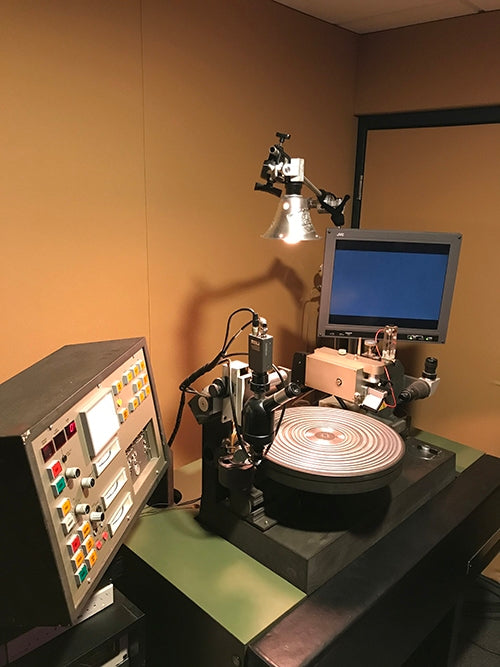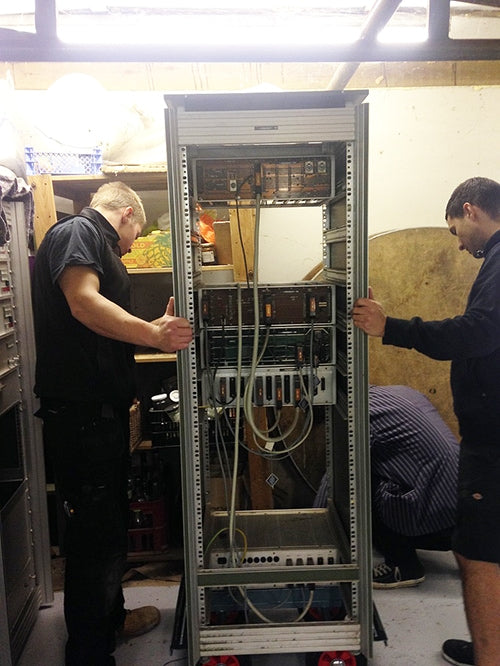In previous installments (Issue 151, Issue 152 and Issue 153), J.I. Agnew presented a historical overview of record-cutting lathes, and looked at some models from Neumann.)

While the Neumann VMS-80 and VMS-82 record-cutting lathes were endowed with plenty of automation systems, installing and setting them up was (and still is) a major challenge. First, they are heavy. Not only that, they are also very sensitive! The heavy platter must first be removed before attempting to transport the lathe from one place to another. Upon installation in a new location, first, the entire lathe needs to be leveled. Then, after the platter is reinstalled, this too needs to be leveled carefully and checked for vertical run-out. A platter with excessive run-out would make it very difficult, or entirely impossible, to maintain a stable groove depth. The groove depth is around 25 µm (0.025 mm or 0.001 inch) on average and can go as low as 12 µm (0.012 mm or 0.0005″), so the Neumann platter run-out could be adjusted to be as low as +/- 1 µm (0.001 mm or 0.000039″), measured at the outer diameter.

It is not easy to achieve such a specification, and most competing manufacturers of disk recording lathes were a bit behind in this respect. Most consumer-oriented turntables are an order of magnitude worse when it comes to platter run-out.

The control systems for groove depth and pitch would then need to be calibrated with the aid of the microscope provided with the lathe.
Next up is the calibration of the cutting amplifier rack, which involves setting the signal levels for the two channels so that the cutter head would cut equally loud on the left and right channels. Then, adjusting the amount of motional feedback for each channel to achieve linear operation, and also adjusting the cutter head protection system so that it will protect the cutter head in case of overload, while also making sure that it does not come into action sooner than necessary. Other aspects of the cutting amplifier also need to be calibrated.

Partially disassembled VMS-82 lathe, in the process of being moved in at Abbey Road Studios. Courtesy of Miles Showell.
It is also imperative to ensure that the vacuum suction system for chip removal is operating reliably. (The process of cutting the groove generates chips as waste.) It is not uncommon for the suction system to get clogged halfway through a cut, or fail to pick up the chip. When cutting lacquer, this is a hazard, because of the use of a heated stylus to cut the disk. If the chip is not effectively removed during the cutting, it will adhere to the stylus, causing more of the lacquer material to ball up there, and soon catch fire. It is worth noting that the lacquer disks used in vinyl record manufacturing are essentially a nitrocellulose lacquer formulation, which is also used, in shredded up form, as the smokeless powder that has replaced black powder in modern firearm ammunition.
The VMS-80 lathe at Townsend Mastering. The control panel is on the left, with the cutting amplifier rack under the control panel, the lathe and control electronics in the middle, and the microscope monitor on the right. Courtesy of Nick Townsend at Infrasonic Sound.

The lacquer disks are highly combustible, and the chip produced by the cutting operation is extremely easy to ignite, which is why the chip jar that collects it in a lathe’s suction system is filled with water, aiming to keep the collected chip below the surface of the water to eliminate the oxygen supply that would be needed to sustain combustion. Even the static charge produced by chips rubbing together as they collect in a jar would be enough to produce a water-shedding obituary extolling what a fantastic mastering engineer you WERE, before the chip accident…(https://www.youtube.com/watch?v=X_hqLmxvpiI)?
The recent sudden end to the activities of the Appollo/Transco lacquer production operation in Banning, CA in February, 2020 shall act as a reminder for cutting engineers worldwide to always be on guard.

A Neumann VMS-82 lathe without the platter and suspension unit, in the process of being moved in at Abbey Road Studios, St Johns Wood, London, UK. Courtesy of Miles Showell.
With all this said, what do the VMS-80 and VMS-82 sound like? Well, for starters, we should take a scientific approach: The Analogue Productions Test Record The Ultimate Analogue Test LP was cut on a VMS-80 lathe, by Barry Wolifson at Sterling Sound. So, get out your measurement instruments and compile a test report! The FloKaSon test record, FloKaSon Reference Series: Testtone Record Vol.1 FSTD-001 was also cut on a Neumann VMS-80 by Flo Kaufmann, using a Neumann SX-74 cutter head with a modified Neumann cutting amplifier rack.
 FloKaSon Reference Series: Testtone Record Vol.1 FSTD-001 (2016), cut on a Neumann VMS-80. Courtesy of Flo Kaufmann, FloKaSon, Switzerland.
FloKaSon Reference Series: Testtone Record Vol.1 FSTD-001 (2016), cut on a Neumann VMS-80. Courtesy of Flo Kaufmann, FloKaSon, Switzerland.As for real music, Miles Showell, mastering engineer at Abbey Road Studios in London, UK, recently told me that the very first master he cut, as soon as the converted-to-lacquer Neumann VMS-82 was installed and freshly calibrated, was for the 50th anniversary release of the Beatles’ Sgt. Pepper’s Lonely Hearts Club Band. By looking up the work of Miles at Abbey Road, you can find numerous other great-sounding records that showcase just how good the VMS-82 can sound in the hands of a qualified mastering engineer, when properly installed in a world-class mastering facility.

Miles Showell and Crispin Murray with the Neumann VMS-82 lathe, during the process of moving it in at Abbey Road. Courtesy of Miles Showell.
Jumping to the other side of the pond, the VMS-82 lathe at Masterdisk in Peekskill, New York, was converted to cut lacquer at some point in 2005. The work of Scott Hull, owner and chief engineer of Masterdisk, can demonstrate the equally impressive capabilities of the converted Neumann VMS-82 in the hands of a highly respected mastering engineer, using the SX-74 cutter head (just like a VMS-80 would). Scott is particularly proud of his cut for Steely Dan’s Two Against Nature album, cut last year at 33 rpm, and again this year at 45 for Acoustic Sounds. (This appears to be sold out at the present time.)
For a demonstration of the capabilities of the Neumann VMS-82 in its original capacity for cutting DMM (direct metal mastered) disks, cutting a copper coated disk, with due attention to detail, in a world-class facility and again, operated by a highly experienced cutting engineer, look no further than the work of Günter and Hendrik Pauler at Pauler Acoustics in Northeim, Germany. Their most impressive achievement to date, in my opinion, would be the DMM Dubplate Vol 1, discussed at length in Issues 147, 148 and 149.
Header image: Crispin Murray next to the VMS-82 at Abbey Road Studios. Courtesy of Miles Showell.













0 comments